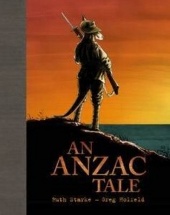The ANZAC tale by Ruth Starke

Ill. by Greg Holfeld. Working Title Press, 2013. ISBN 9781921504532.
(Age: 10+) Recommended. Graphic Novel. Anzac. Australian history.
War. With the one hundredth anniversary of the landing at Anzac Cove
approaching, many books pertaining to Australia's involvement in
this catastrophe are being written and published, reappraising what
happened. This timely graphic novel by Starke and Holfeld, presents
the story of Anzac for a younger generation. People may think they
know about Anzac. It is a story reiterated each year on Anzac Day,
but Starke presents it anew from the perspective of two young men,
Roy and Wally, who join up from the same farming community. We see
their enlistment and the reasons they do so, their training, the
weeks of waiting in Egypt, the landing at Anzac Cove, and the
terrible eight months spent there for no advancement at all, and
then the evacuation. All the while we see these two young men,
commenting on what they see around them, involved in the many
skirmishes and battles, fighting dysentery, flies, their own fear
and even communicating with some of their enemy, the Turks, POW's
being used as grave diggers for some of the 8000 who were killed.
Starke's spare dialogue pulls no punches. She neither embellishes
nor understates. The women at home question what their men are about
to do, but then get down to writing letters, knitting socks, sending
parcels, all the while reading of the terrible cost of the battle
for the peninsula in their papers. The men at the front comment on
their situation, but do as the officers order, until finally, the
order for evacuation comes and a plan put in place to get the men
off safely without the Turks knowing.
The illustrations by Holfeld are unexpected. The characters take the
form of iconic animals of each national group represented. So the
Australians are kangaroos: the many, the cannon fodder, while the
officers are less common animals, koalas, wombats and the screeching
sulphur crested cockatoos. These will intrigue as readers ponder why
they are depicted in such a way. The illustrations reveal the daily
routines of Anzac Cove, the fetching of water, the ever present
rifle over the shoulder, the arrival of the mail, the new recruits,
the barrage of shells from the enemy. In the background we can spy
Simpson and the donkey, tins of bully beef, places we know about:
Nek and Lone Pine. Holfeld contrasts the awful pages depicting war
with the quiet of the women, reading the lists of those who have
died, adding to the anguish of those at home.
Every time I read this book, I find something new to think about,
comparing it with others on the same theme. I found the last few
pages of facts underscoring why some things have been included both
in the text and illustrations, most enlightening, and the map and
time line are useful for all readers. For teachers there is an array
of themes and ideas to work with: bravery, enlistment, mateship,
war, the home front, amongst others, and there are teacher notes to
accompany this book on the publisher's website.
Fran Knight